Figure 1.
Cellular mechanisms of memory reconsolidation. Postsynaptic noradrenergic signaling strengthens emotional memory reconsolidation by enhancing N-methyl-D-aspartate (NMDA) receptor-dependent synaptic plasticity. α1-Adrenergic receptor (AR) activation enhances phospholipase C (PLC) signaling to activate Ca2+/calmodulin-dependent protein kinase II (CaMKII). CaMKII associates with the NMDA receptor subunit GluN2B, and this binding facilitates AMPA (α-amino-3-hydroxy-5-methyl-4-isoxazolepropionic acid) receptor phosphorylation and promotes NMDA receptor-dependent synaptic plasticity. α2-AR activation inhibits adenylyl cyclase, whereas β-AR activation stimulates adenylyl cyclase. Adenylyl cyclase activation facilitates protein synthesis and GluN1 phosphorylation via cAMP-PKA-CREB. Thus, NMDA, α1, and β receptor signaling modifies existing membrane-bound proteins and induces synthesis of new proteins for the orchestration of reconsolidation-dependent synaptic plasticity. In contrast, α2-ARs function as inhibitory presynaptic autoreceptors (not illustrated) and as postsynaptic receptors (illustrated) to reduce α1 and β-AR receptor signaling.

